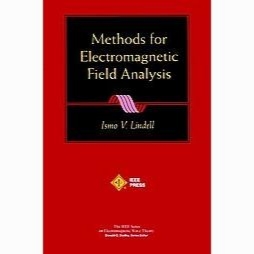Methods for electromagnetic field analysis: 2nd
- نوع فایل : کتاب
- زبان : انگلیسی
- مؤلف : Ismo V Lindell
- ناشر : New York : Institute of Electrical and Electronics Engineers ; Oxford [England] ; New York : Oxford
- چاپ و سال / کشور: 1995
- شابک / ISBN : 9780780311541
Description
1 ASPECTS OF NUMERICAL ANALYSIS Interpolation and approximation 1.1 Interpolation 1.2 Inverse interpolation 1.3 Interpolation in two dimensions 1.4 Approximation 1.5 L2 -norm approximation 1.6 Rational approximation 1.7 Trigonometric interpolation Solution of equations 1.8 Solution of an equation 1.9 Systems of non-linear equations Matrices 1.10 Matrices 1.11 Matrix norms Linear equations 1.12 Linear equations-direct methods 1.13 Iterative methods 1.14 Matrix eigenvalues Generalized inverse 1.15 The generalized inverse 1 1 1 9 9 12 15 23 28 31 31 40 40 40 46 51 51 57 60 66 66 2 WAVEGUIDES AND DIFFERENCE EQUATIONS 72 2.1 Introduction 72 2.2 Waveguides 74 2.3 Numerical derivatives 78 2.4 Properties of difference equations 83 2.5 TEM modes 93 2.6 The dominant mode 96 2.7 Higher modes 98 2.8 Direct methods 100 2.9 Other equations 108 2.10 Conformal mapping 109 2.11 Waveguides containing dielectric 109 2.12 Microstrip transmission lines 112 2.13 Other methods for guides 117 2.14 The fast Fourier transform 117 x CONTENTS 3 OPERATORS AND EIGENVALUES 120 Preliminaries 120 3.1 Hilbert space 120 3.2 Linear operators 123 3.3 Bounded linear operators 127 Partial differential equations 133 3.4 Integral and partial differential equations 133 3.5 The cavity resonator 143 Unbounded operators and eigenvalues 146 3.6 Unbounded operators 146 3.7 Approximation theorems 149 3.8 Point matching 152 4 VARIATIONAL METHODS AND OPTIMIZATION 156 The derivative of an operator 156 4.1 The derivative 156 4.2 Mean-value theorem 162 4.3 Higher derivatives 167 4.4 Convex functionals 170 Newton's method for operators 172 4.5 Newton's method 172 Optimization 181 4.6 Unconstrained optimization 181 4.7 The effect of constraints 191 Variational principles 194 4.8 Variational approach 194 4.9 Examples 200 4.9.1 Network analysis 200 4.9.2 Integral equations 202 4.9.3 Ordinary differential equations 203 4.9.4 Poisson's equation 205 Waveguides 208 4.10 The capacitive iris 208 4.11 Another form of variational principle 212 4.12 The inductive iris 215 4.13 Vector optimization 218 4.14 Sobolev spaces 219 5 NUMERICAL ASPECTS OF VARIATIONAL METHODS 222 Minimal systems 222 CONTENTS 5.1 Galerkin's method 5.2 Minimal systems 5.3 Positive-definite operators 5.4 Stability Integral equations 5.5 Compact operators 5.6 Integral equations 5.7 Equations of the first kind Numerical trial functions 5.8 Finite elements 5.9 Finite differences 5.10 Comparison between finite difference and finite element 5.11 Eigenvalues Numerical integration 5.12 Quadrature 6 ANTENNAS AND INTEGRAL EQUATIONS Wire antennas 6.1 Introduction 6.2 The perfectly conducting wire 6.3 General excitation of the infinite wire 6.4 The semi-infinite wire 6.5 The finite wire 6.6 The receiving antenna 6.7 Numerical methods 6.8 Curved antennas 6.9 Log-periodic antennas 6.10 Loads and arrays Solid antennas 6.11 Wire grid models 6.12 The electric-field integral equation 6.13 Uniqueness 6.14 The magnetic-field integral equation 6.15 The Fredholm alternative 6.16 Compactness and other properties of the MFIE 6.17 Other integral equations 6.18 Numerical considerations for surfaces 6.19 Singular integrals 6.20 The algebraic system 6.21 The null-field method 6.22 The impedance boundary condition ~.23 Absorbing boundary conditions 6.24 The surface radiation condition xi 222 225 230 234 241 241 245 258 262 262 273 275 276 276 276 286 286 286 286 290 297 299 302 307 316 321 323 324 324 328 335 337 340 346 348 357 359 360 362 362 366 372 xii CONTENTS Dielectric antennas 373 6.25 The infinite dielectric circular rod 373 6.26 Modal excitation 377 6.27 The finite rod 381 6.28 General shapes 381 6.29 Homogeneous isotropic dielectric 385 6.30 Uniqueness for the homogeneous isotropic dielectric 388 Appendix: Geometry of surfaces 389 7 TRANSIENT PHENOMENA 395 7.1 Finite methods 395 7.2 Integral equations in the time domain 396 7.3 Numerical methods for thin wires in the time domain 400 7.4 Perfectly conducting bodies 404 7.5 Numerical matters 405 7.6 The harmonic approach versus the impulse response 409 7.7 The Laplace transform 410 7.8 The location of the poles 417 7.9 The impulse response 423 7.10 Practical determination of the positions of the poles 427 7.11 Prony's method and modifications 428 8 GEOMETRIC THEORY OF DIFFRACTION 434 8.1 The high-frequency approximation 434 8.2 Geometrical optics 438 8.3 The ray and transport equations 441 8.4 The stratified medium 446 8.5 Fermat's principle 451 Numerical solution of ordinary differential equations 456 8.6 Multistep methods 457 8.7 Runge-Kutta methods 465 8.8 Extrapolation 468 8.9 Systems of differential equations 469 Canonical problems 469 8.10 Geometrical optics revisited 469 8.11 Focusing 470 8.12 Reflection by stratification 475 8.13 Edges 482 8.14 Edge rays 489 8.15 Uniformly valid approximations 492 8.16 Double edge diffraction 499 8.17 Emission from a waveguide 509 8.18 The wedge 517 8.19 The effect of curvature 522 8.20 Generalization 535 CONTENTS xiii 8.21 Optimal curvature 539 8.22 The diffraction matrix for a curved boundary 539 8.23 Diffraction by a discontinuity in curvature 541 8.24 Reflector antennas 549 Leaky rays 553 8.25 Gaussian beams and complex sources 553 8.26 Complex rays 557 8.27 Optical fibres 559 9 SOURCE DETECTION 568 9.1 General considerations 568 Inverse scattering 570 9.2 Low frequencies 570 9.3 High frequencies 573 9.4 Scattering in the time domain 577 9.5 Moving targets 579 The inverse source problem 581 9.6 Harmonic sources 581 9.7 Inhomogeneities 584 9.8 Statistical considerations 585 9.9 Correlation techniques 590 9.10 Far-field cross-correlation technique 591 Holographic techniques 596 9.11 Basic principles of holography 596 9.12 Location of an inhomogeneity 601 9.13 Field in the aperture of an antenna 602 9.14 Zeros of entire functions 605 Synthesis of radiation patterns 607 9.15 General considerations 607 9.16 Synthesis by series expansion 609 9.17 Construction errors 611 9.18 Constrained aperture norm 612 9.19 Directivity 616 9.20 Penalty functions 617 Array signal processing 618 9.21 Adaptive beam forming 618 9.22 Simultaneous multiple beams 622 9.23 Time-varying arrays 625 References 627 Index 641


